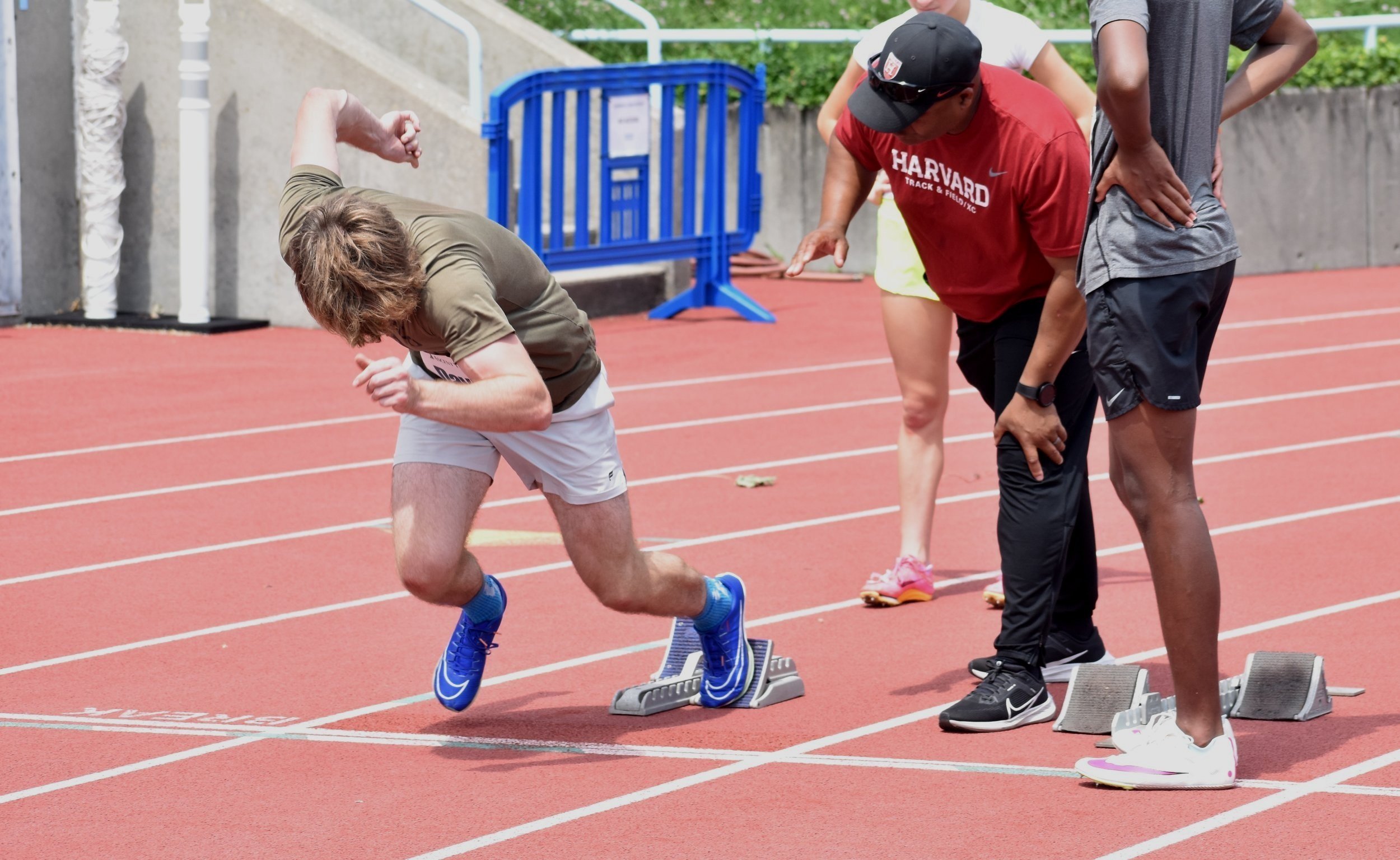
401. Advanced weight training design for speed and Power Sports
Learn to plan and write weight training workouts for speed and power sports in a self-paced course taught by veteran instructor and founder of USTFCCCA’s Track & Field Academy, Boo Schexnayder.
~6 Hrs. Duration | 34 Pages of Course Materials | 10 Knowledge Retention Checks
This course is also included in the Weight Room Bundle and the Strength and Conditioning Bundle.
Course instructor
BOO SCHEXNAYDER
Director, Consultant, Coach
SAC Speed
With over 40 years of experience in coaching and consulting, Boo Schexnayder is regarded as one of the world’s premier field event coaches.
He was the mastermind behind 26 NCAA Champions during his collegiate coaching career, was part 13 NCAA Championship teams and a pair of Juco National titles, and he has developed a host of conference champions and All-Americans.
Schexnayder has also been a prominent figure on the international scene. He has coached 18 Olympians and 7 Olympic/World Championship medalists, and served on coaching staffs for Team USA to the 2003 Pan Am Games in Santo Domingo, the 2006 World Junior Championships in Beijing, and was the Jumps Coach for Team USA at the 2008 Olympics in Beijing.
-
Schexnayder has been just as successful off the track. He is certified at Level I, II and III, and owns the prestigious Master Coach Designation from USA Track and Field. He is also certified by the NSCA as a Strength and Conditioning coach.
Schexnayder has been heavily involved in Coaching Education. He formerly served as national chair of USATF’s Coaching Education Committee, Jumps Subcommittee chair, and chair of the Biomechanics subcommittee.
Schexnayder was also the founder of the Track and Field Academy, the educational branch of the US Track and Field and Cross Country Coaches Association. He served as program director from its inception in 2009 through 2017, and still serves as an instructor in biomechanics, training design, and event-specific courses.
GET ACCESS:
COURSE DESCRIPTION
A COMPREHENSIVE ROAD MAP TO SPEED AND POWER GAINS
In this online self-paced course, Boo Schexnayder details the process of planning and writing weight training workouts for speed and power sports. This course is applicable to all Olympic and team sports that are speed- and power-based.
Advanced Weight Training Design covers how to adjust programming as athletes move from developmental to elite levels, and shows how to arrange training phases, write workouts for each phase, and manage in-season weight training, with extra attention to team sport needs.
Designed for coaches, athletes, fitness enthusiasts, physical therapists, and athletic trainers, this course provides a comprehensive roadmap to unlock explosive speed and power gains. It’s also the best study guide for the USTFCCCA Strength and Conditioning course.
Please note that this course differs from 101. Weight Training for Speed, Power and Sports Performance in that it covers long-term planning and workout writing in complete, high-level detail, and no technical issues are addressed. We suggest taking 101. Weight Training for Speed, Power and Sports Performance before taking this course for explanations on the types of strength and lifts, teaching progressions, and specific technique pointers.
This course features archived video content that can now only be found here in this course, while the study notes and knowledge retention checks are new materials that are unique to this course.
GET ACCESS:
COURSE LAYOUT
01. CATEGORIES OF WEIGHT TRAINING EXERCISES
Weight training exercises can be classified into distinct categories, each serving a unique purpose within a training program. Understanding these categories is essential for effectively designing and implementing training protocols.
VIDEO: Categories of Weight Training Exercises
STUDY NOTES: Categories of Weight Training Exercises
KNOWLEDGE RETENTION CHECK: Categories of Weight Training Exercises
02. COMPATIBLE TRAINING CONSTRUCTS
When training an athlete, the key to achieving high levels of adaptation is sending very clear biochemical messages to the body's adaptive processes. The clarity of these messages is determined by how different types of training are combined into sessions.
VIDEO: Compatible Training Constructs
STUDY NOTES: Compatible Training Constructs
KNOWLEDGE RETENTION CHECK: Compatible Training Constructs
03. FOUNDATIONS OF WEIGHT TRAINING
This chapter outlines key principles of weight training, focusing on purposeful exercise selection, program design, and balancing localized and global physical responses. It emphasizes the importance of managing variables like tension, range of motion, and exercise balance while adjusting intensity based on real-time performance for effective athletic development.
VIDEO: Foundations of Weight Training
STUDY NOTES: Foundations of Weight Training
KNOWLEDGE RETENTION CHECK: Foundations of Weight Training
04. TRAINING PHASES
Annual or long term weight training can be organized into four phases: 1. Neural Preparation Phase 2. Strength Development Phase 3. In-Season Management Phase 4. Critical Competition Management Phase
VIDEO: Training Phases
STUDY NOTES: Training Phases
KNOWLEDGE RETENTION CHECK: Training Phases
05. OLYMPIC LIFTING PROTOCOLS
This chapter covers three Olympic weightlifting protocols—Basic Power Development, Rate of Force Development, and Rate of Force Development Preparation—used progressively across four training phases to build power and strength safely.
VIDEO: Olympic Lifting Protocols
STUDY NOTES: Olympic Lifting Protocols
KNOWLEDGE RETENTION CHECK: Olympic Lifting Protocols
06. STATIC LIFTING PROTOCOLS
This chapter details three static weightlifting protocols—Absolute Strength Development (ASD), Absolute Strength Preparation (ASP), and Absolute Strength Complementary (ASC)—designed to progressively build and maintain strength throughout a four-phase training year.
VIDEO: Static Lifting Protocols
STUDY NOTES: Static Lifting Protocols
KNOWLEDGE RETENTION CHECK: Static Lifting Protocols
07. BALLISTIC LIFTING PROTOCOL
This chapter explains Ballistic weightlifting protocols, particularly Reactive Strength Development (RSD) units, which use high-speed, low-load exercises to enhance explosive power and reactive strength.
VIDEO: Ballistic Lifting Protocol
STUDY NOTES: Ballistic Lifting Protocol
KNOWLEDGE RETENTION CHECK: Ballistic Lifting Protocol
08. REGIONAL LIFTING PROTOCOLS
This chapter covers Regional lifting protocols, focusing on bodybuilding and hypertrophy production to target specific muscle groups, promote hormonal benefits, and enhance recovery.
VIDEO: Regional Lifting Protocols
STUDY NOTES: Regional Lifting Protocols
KNOWLEDGE RETENTION CHECK: Regional Lifting Protocols
9. ASSEMBLING THE PROGRAM: A TUTORIAL
This chapter outlines the process of assembling weight training programs for different phases of the training year, focusing on developmental smaller body types and providing sample workouts for various phases.
VIDEO: Assembling the Program – A Tutorial, Part 1
STUDY NOTES: Assembling a Program for Phase 1 and Phase 2
SAMPLE CHARTS: Phase 1 and Phase 2
KNOWLEDGE RETENTION CHECK: Assembling a Program for Phases 1 and 2
VIDEO: Assembling the Program – A Tutorial, Part 2
STUDY NOTES: Assembling a Program for Phase 3 and Phase 4
SAMPLE CHARTS: Phase 3 and Phase 4
KNOWLEDGE RETENTION CHECK: Assembling a Program for Phase 3 and Phase 4
GET ACCESS:
What to Expect
EXPERT INSTRUCTORS
Our instructors are proven track & field veterans with experience as educators, program directors, and coaches at the collegiate, professional, and international levels. Each course has been meticulously planned and prepared by its instructor to ensure a comprehensive learning experience for every student.
SELF-PACED LEARNING
Learn on your own terms in our self-paced educational environment. Progress through video lessons, review study guides, and complete knowledge retention checks all on your own schedule. You can even skip sections and return to them later. There’s no time requirement for finishing the course. Once you buy it, you can access it forever.
DOWNLOADABLE CONTENT
Each course includes supplementary documentation – from study guides and glossaries to diagrams and inventories. All of this documentation is downloadable. Save it, print it, and take it with you to practices and meets to make an immediate impact with your newfound knowledge. Videos you can access wherever you have an internet connection.
KNOWLEDGE RETENTION CHECKS
Complete each course confidently with the help of our knowledge retention checks. After every module, these short quizzes test your knowledge of key concepts to ensure your grip on the material is strong.
Knowledge retention checks are optional unless you intend to receive a Certificate of Achievement upon completion, which requires an 80% or better on all.
CERTIFICATE OF ACHIEVEMENT
Showcase your knowledge to administration and staff with a Certificate of Achievement. You’ll have the option to request one of these if you’ve completed every module of the course and passed all knowledge retention checks with a score of 80% or higher.
GET ACCESS:
Frequently asked questions
Don’t see your question below? Contact us.
-
No, you can choose to enroll at any time you’d like, and take however much time you want to; the course will always be there for whatever timeline suits you.
-
Yes and no– it is not possible to download the video lessons, but you can download all PDF materials.
-
There is no time limit to your login, and you can go back and look at any part of the course you want at any time.
-
You must show that you have an understanding of the material by achieving a mark of 80% or higher on the Knowledge Retention Checks– but don’t worry, you can take those Knowledge Retention Checks more than one time if need be.
-
For any course content, we encourage you to write the questions in the Ascent Track Discord in each class section. For any technical issues, you can contact us at support@ascenttrackclinics.com









